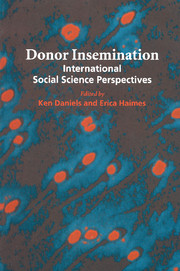Book contents
- Frontmatter
- Contents
- List of figures
- List of tables
- Notes on contributors
- Acknowledgements
- List of abbreviations
- 1 International social science perspectives on donor insemination: an introduction
- 2 The users of donor insemination
- 3 Families created through donor insemination
- 4 The making of ‘the DI child’: changing representations of people conceived through donor insemination
- 5 The semen providers
- 6 The medical management of donor insemination
- 7 Regulation of donor insemination
- 8 Donor insemination and ‘public opinion’
- 9 Concluding comments
- Index
3 - Families created through donor insemination
Published online by Cambridge University Press: 04 August 2010
- Frontmatter
- Contents
- List of figures
- List of tables
- Notes on contributors
- Acknowledgements
- List of abbreviations
- 1 International social science perspectives on donor insemination: an introduction
- 2 The users of donor insemination
- 3 Families created through donor insemination
- 4 The making of ‘the DI child’: changing representations of people conceived through donor insemination
- 5 The semen providers
- 6 The medical management of donor insemination
- 7 Regulation of donor insemination
- 8 Donor insemination and ‘public opinion’
- 9 Concluding comments
- Index
Summary
Introduction
Most people would accept the proposition that sexual relationships, the birth of children and the nurture of infants and young children are normally contained within the set of relationships we call the family. In many respects the family is an elusive concept which describes relationships with which we are all familiar but which, on closer examination, we find difficult to define with precision. Because of our close personal experience of family life we are apt to assume we know what we mean when we speak of the ‘family’. Moreover, it is usual to assume that the word has the same meaning for us that it has for others and that our experience is similar to that of other people. However, while the recognition that family members have a special relationship with each other appears to be ubiquitous, the form and quality of these relationships vary between and within societies and even in the same family group over time.
What makes the study of these relationships even more difficult is that the thoughts one brings to bear on such a study have largely been structured by the very relationships being studied. The subjective nature of family relationships is one which is not readily amenable to objective assessment or measurement using the traditional tools of science and for this reason their detailed study remains either neglected or problematic.
- Type
- Chapter
- Information
- Donor InseminationInternational Social Science Perspectives, pp. 33 - 52Publisher: Cambridge University PressPrint publication year: 1998
- 11
- Cited by



